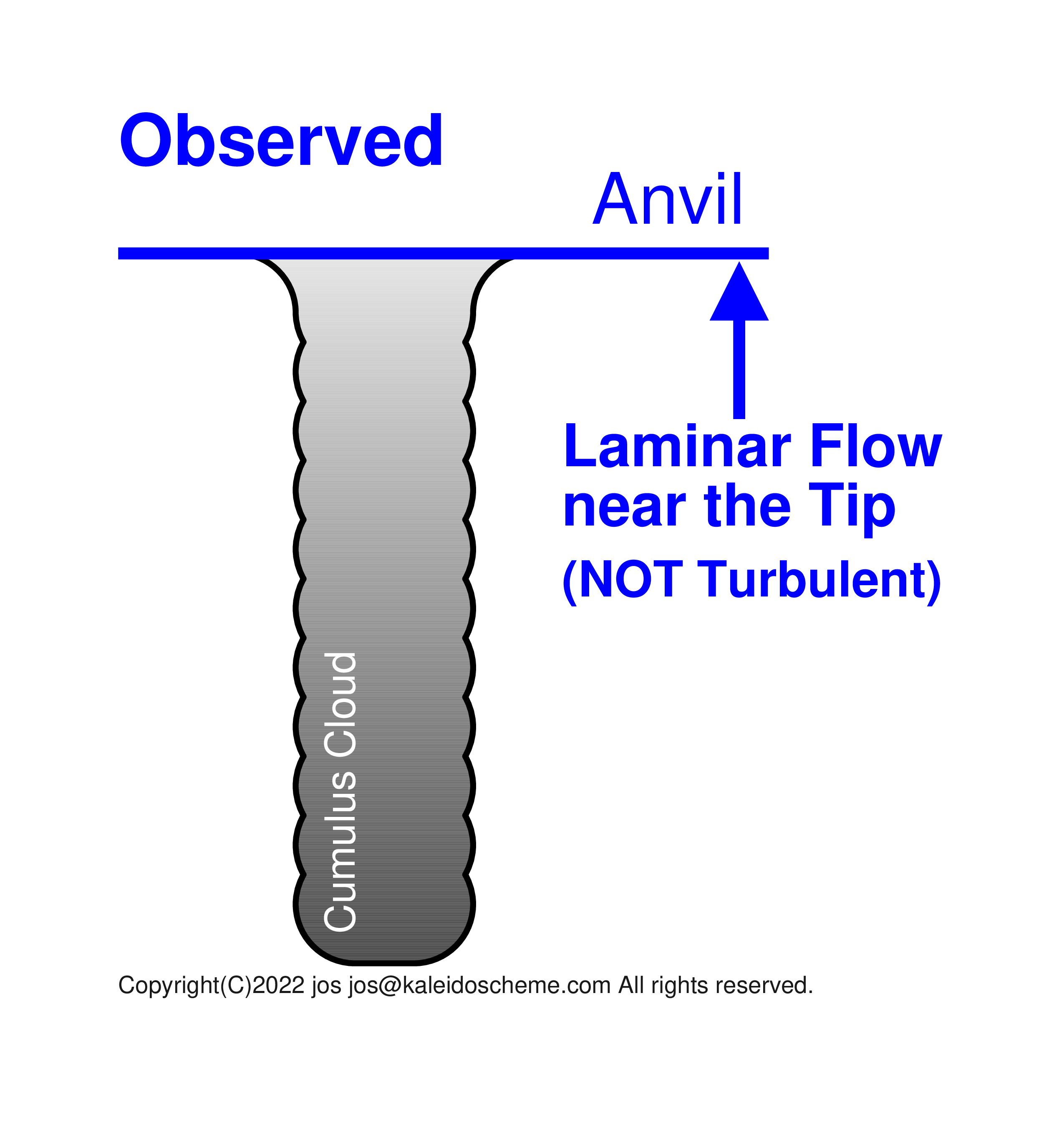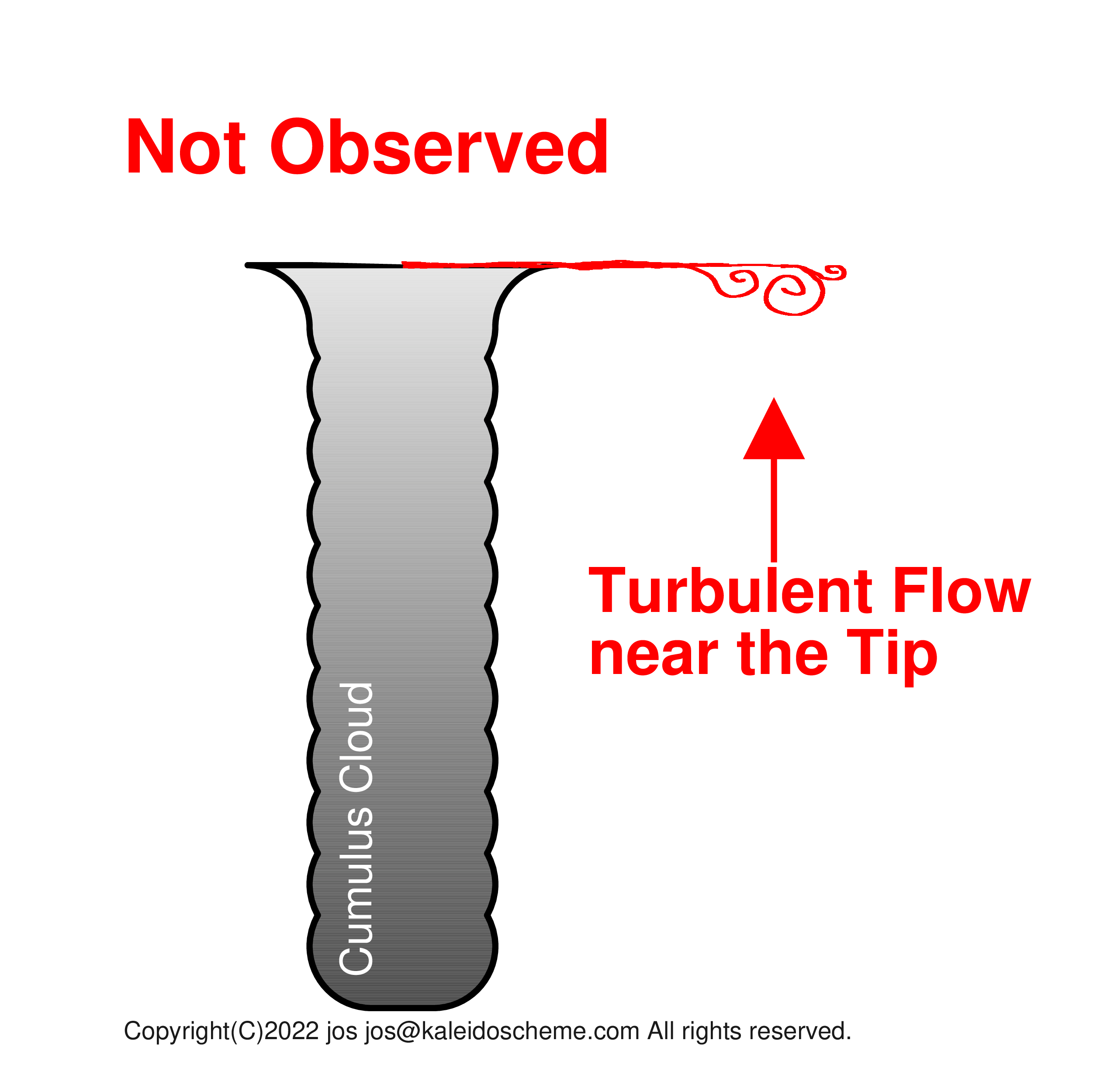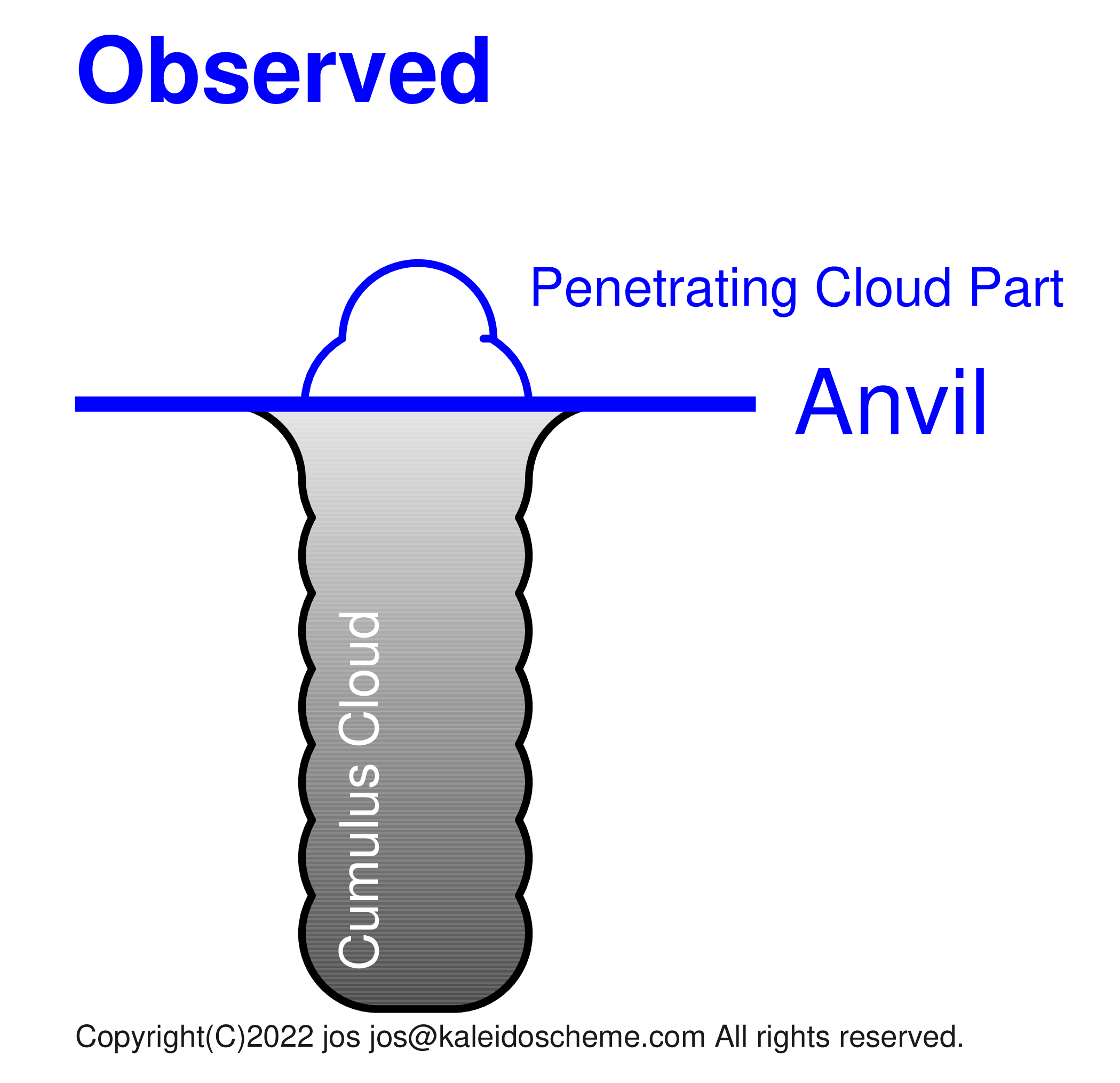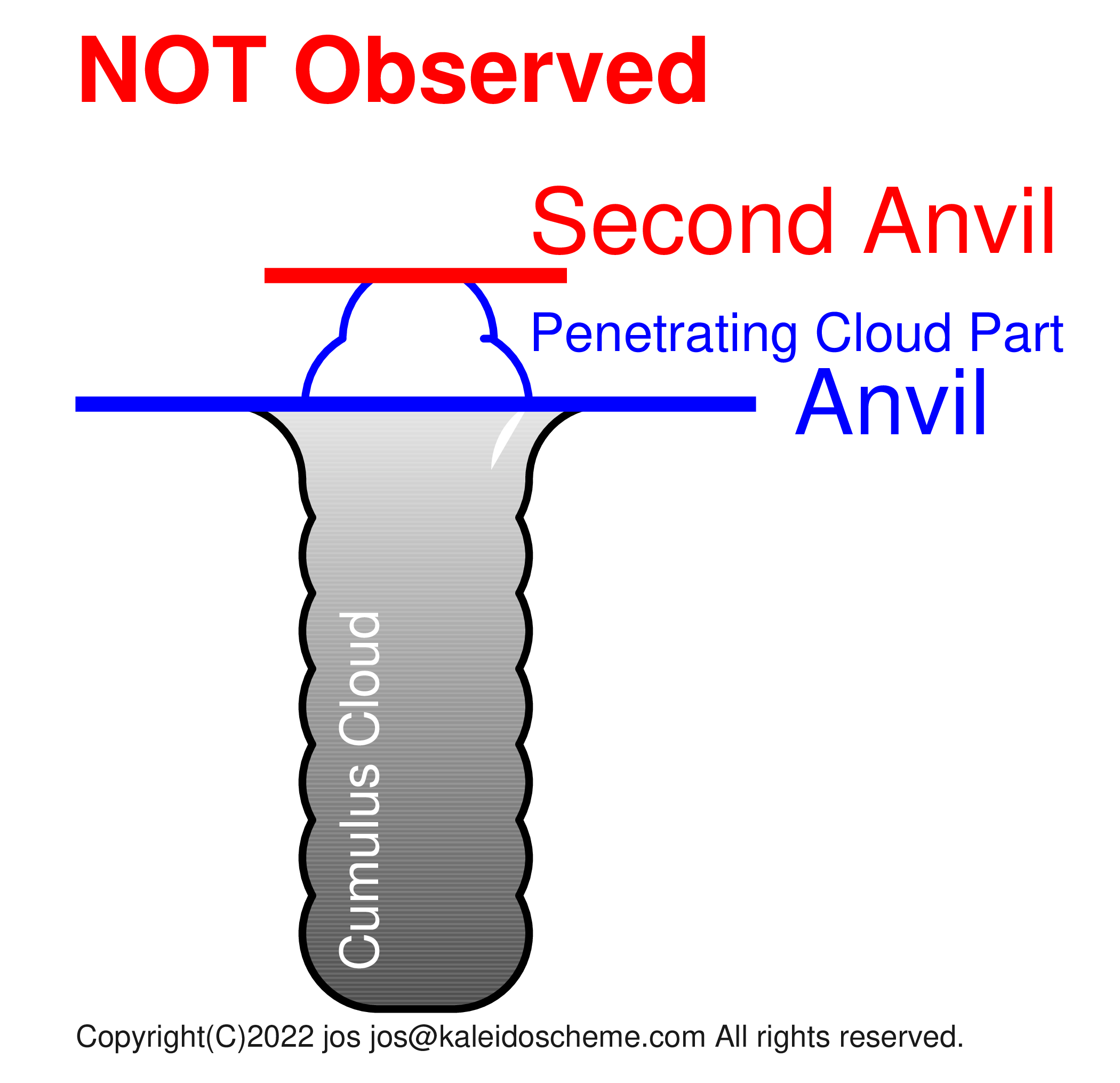
Anvil < rdctheory.cloud
1. General Description
The strongest, and perhaps the only, evidence cited by proponents of Dynamical Detrainment
is the anvil (an anvil-shaped cloud at the top of a cumulus cloud;
often called cumulonimbus as a whole)
that is seen when a cumulus cloud is sufficiently developed.
However, there is no scientific evidence that this is due to dynamical reason.
It may not be easy for the most people
to distinguish from the shape of the anvil alone
whether the anvil is blowing out horizontally from the upper edge of the cumulus
or whether the anvil is being sucked out by the surrounding atmosphere at that level.
If you have a rudimentary knowledge of fluid motion,
however,
it is quite easy to discern from the laminar pattern of the outflow tip
that it is due to suction.
And the sucked outflow near the tropopause can be explained by our
Radiatively Driven Circulation (RDC) mechanism.
The connection of a tropospheric atmosphere,
with a finite radiative cooling rate
and therefore finite thermodynamically balancing subsidence flow,
below a stratospheric atmosphere,
with little radiative cooling and therefore
little thermodynamically balancing subsidence flow,
is a natural structure
that induces a large horizontal compensating outflow due to a large mass divergence
near the tropopause.
[NOTE]
Thus,
anvil can be understood as the horizontal component of RDC that is driven
to compensate for the mass divergence
created by the thermodynamically-balanced subsidence flow
near the tropopause,
which is the boundary between the stratosphere,
which has no RDC subsidence,
and the troposphere,
which has a finite RDC subsidence.
Furthermore,
near the tropopause in the troposphere,
as the temperature lapse rate Γ is close to the dry adiabatic lapse rate
Γd=g/cp,
the RDC subsidence velocity given by Eq.(11) on
the main page
\begin{eqnarray}
{w}_{R}
=
{\left(
\frac{g}{{c}_{p}} - \Gamma
\right)}^{-1}
{\left.
\frac{\partial {T}}{\partial t}
\right|}_{R}
\nonumber
\end{eqnarray}
takes a large value here.
This is one of the reasons why the anvil flow is even stronger.
2. Individual Descriptions

Please search photographs and movies of anvil clouds on the Internet. You will find plenty of results. Those in tropical or subtropical areas are preferable, as they are not affected from the mid-latitudinal disturbances. When looking closely at the photos, (some lumpy/uneven patterns, which are traces of small vortices, can be seen in the neighborhood of the cumulus cloud but) the tips of anvil outflows far from the cumulus cloud usually appear as straight laminar flows (Figure A-1).

Flow fields created by blowing are always accompanied by turbulence at the tips, but turbulence is rarely seen in flow fields created by suction. If anvil were caused by an blowing-out from the cumulus, there should be a lumpy/uneven pattern at the tip of the outflow (Figure A-2). However, we could not find a single picture of anvil with a clear turbulent tip. The anvil photos strongly suggest that the anvil is created NOT by a blowout as assumed in Dynamical Detrainment, BUT with suction by the surroundings, which is a natural result derived from the RDC theory.
[NOTE]
The recent problem is that many AI-generated images of cumulonimbus and anvil clouds
have appeared on the Internet, TV programs, and movies.
In many of them,
the anvil clouds have a blowing flow pattern due to the user's assumption.
Please make sure that the image is of an actual anvil cloud in nature
before checking it out.
A demonstration is often given in which a colored heavy liquid is dropped into the water of an aquarium and shown spreading horizontally at the bottom. They say it is a reproduction of an anvil (upside down). Unfortunately, it is not. The flow pattern near the tip of their "anvil" is always a turbulent structure (as shown in Figure A-2 but upside down). Unless the liquid being dropped is very heavy, such as mercury (liquid silver), to make large difference in density between the two liquids, or, unless the liquid is very viscous like syrup, it is difficult to create a laminar flow structure like that of a real anvil. The difference in the flow pattern near the tip shows that they are completely different phenomena. The real anvil is the result of suction as derived from the RDC theory, not of blowout as assumed in the Dynamical Detrainment.
[NOTE]
Furthermore, anvil clouds are found only near the tropopause.
If cumulus clouds are ejected outward as they lose buoyancy,
it would not be surprising if anvil-like clouds were formed at much lower altitudes.
This fact also suggests that the atmospheric structure near the tropopause
is necessary for the formation of anvil clouds.
You might argue that anvils do not form at low altitudes
because there is no strong temperature inversion layer of the tropopause at low altitudes;
the inversion layer would prevent air parcels from rising.
O.K., let's see the next.

Another phenomenon that supports RDC is the presence of a part of cumulus cloud that penetrates the anvil of the cumulus cloud and reaches even higher altitudes (Figure A-3). If an anvil is a phenomenon in which air parcels in a cumulus cloud lose their buoyancy and are pushed out to the surrounding area horizontally, it is unlikely that air parcels can reach above the anvil when it is formed, because the air parcels are well mixed in the cumulus domain. Some of you may say that there must have been two kinds of air parcels, one that lost buoyancy and the other that remained buoyant, but how could a mixed air mass (actually it is not individual parcels but a continuum) be separated into two groups? Such a separation contradicts the second law of thermodynamics. It is a very unnatural idea. Air mass with sufficient thermal energy rises above the level of the tropopause within the cumulus cloud. Apart from the motion within the cumulus, a strong RDC flow occurs near the tropopause, defined by the vertical profile of radiative cooling, due to suction by the surrounding atmosphere, which can be interpreted as the formation of an anvil. In many cases, all of the upward mass flux within the cumulus cloud that could rise above the tropopause is consumed by the horizontal RDC flow, leaving no portion of the cloud penetrating the tropopause. In this case, it should appear as if the flow is simply blowing out from the top of the cumulus to the surrounding atmosphere. Most people fall for this trick of nature and lose sight of the essence.

Furthermore, if an air parcel that loses buoyancy always flows out horizontally, then the second anvil could form at the top of the cloud when the air that rises through the anvil loses buoyancy (Figure A-4), but no such second anvil is found in the cumulus cloud photographs. It suggests that, the formation of anvil is restricted only to the vicinity of the tropopause where a jump in radiative cooling rate (i.e., little radiative cooling in the stratosphere above the tropopause, while finite radiative cooling in the troposphere below the tropopause) occurs to generate large horizontal outflow in RDC independent of the altitude at which buoyancy becomes zero.
[NOTE]
So far, we have found no photograph of a second anvil.
This fact supports the RDC mechanism.
It is because there appears to be no special radiative structure
in the lower stratosphere above the (first) anvil
for generating strong RDC flows.
However, if there were a second anvil,
it would not immediately overturn the RDC theory.
In that case, according to the RDC approach,
there must be some radiative feature near the altitude of the second anvil,
which we are not aware of yet, and we just need to find it.
In order to explain the second anvil by Dynamical Detrainment,
on the other hand,
there must be the dynamical feature of zero-buoyancy at that altitude.
So the second anvil should be a good subject for comparative discussion,
if it exists.
A clear distinction must be made in observations
between anvil (with cumulus cloud) and cirrostratus (without cumulus cloud),
though.
Similarly, we have never seen short cumulus clouds form anvils at altitudes below the tropopause. Anvils form ONLY at the altitude of the tropopause. The loss of buoyancy of the air parcel in a cumulus cloud does not cause it to flow out horizontally. The explanation of anvil formation by loss of buoyancy must be reconsidered. The reason why anvils only form at tropopause altitude is that the tropopause has a special thermodynamic structure, all of which can be explained consistently if we consider that anvils are formed by RDC.
3. Summary
Most people believe that air parcels that have lost buoyancy
within the cumulus can flow unconditionally and freely out of the cumulus.
To use an intuitive expression that may be misleading,
most people seem to think that the inside of a cumulus cloud
is "something hard" like a "core"
and the outside of a cumulus cloud is "just an atmosphere
with no resistance at all".
But they are the exact opposite.
While interior of the cumulus cloud may be stirred up and softened
by convection and mixing,
the outside of the cumulus has an atmospheric structure that
is solidified by thermodynamical equilibrium and mass continuity.
The flow field outside the cumulus cloud is strictly regulated
by the RDC mechanism.
It is extremely difficult for air parcels to flow out of the
cumulus cloud by breaking the solidified atmospheric structure,
i.e., by deviating from the RDC restriction.
This is because if such a flow were to occur,
it would change the current equilibrium state
of the atmosphere to a different state.
The mechanism of RDC can be understood intuitively
if we consider that only the exact air amount
which the surrounding atmosphere accepts
is allowed to flow out of the cumulus domain.
In other words, it is the atmospheric structure outside the
cumulus that regulates the outflow from the cumulus,
not the circumstances inside the cumulus domain.
Some of you who want to give anvil special treatment may argue that if anvil is an RDC, why is only anvil visible and the other flows of RDC invisible? The reason lies in the different nature of the mass divergence that makes these flows, setting aside the difference in magnitude of the mass divergence. In the case of anvil, the flow is due to the formation of a layer of large mass divergence near the tropopause, i.e., between the troposphere and stratosphere with different radiative cooling properties. This layer extends horizontally at a constant altitude. Inside the cumulus cloud, an air parcel has a saturated water vapor content with a relative humidity of about 100%, and the thermodynamical situation does not change when the air parcel flows out into this horizontal layer. Since the advection is at the same altitude, the relative humidity remains nearly 100%, and the anvil is visible as a cloud. On the other hand, the RDC flow at a lower altitude than the anvil still occurs to compensate for the mass divergence in the atmosphere. This mass divergence is, however, generated in the vertical flow field of subsidence. Therefore, air parcel that exits the cumulus cloud is immediately lowered in altitude by the subsidence flow. As shown in the description of the RDC parameterization (Fig. 5), in this case the temperature in the air parcel rises along the line of the temperature lapse rate Γ in the surrounding atmosphere. The amount of water vapor in the outflowing air parcel does not change, while the amount of saturation water vapor increases with temperature, so that the relative humidity, expressed as the ratio of the two, goes below 100%. This means that RDC flows at altitudes below anvil are not visible as clouds, since the outflow from a cumulus cloud immediately leaves the air parcel unsaturated.
It can be seen that anvil is not accepted as evidence of Dynamical Detrainment, but is more convenient to be taken as evidence of RDC. No phenomena should be judged on the basis of intuition and preconception. Finally, Dynamical Detrainment seems unrealistic and questionable; RDC is much more likely.
Anvil < rdctheory.cloud
Exhibited on 2022/08/20
Last Updated on 2025/02/13
Copyright(C)2022-2023 jos <jos@kaleidoscheme.com> All rights reserved.